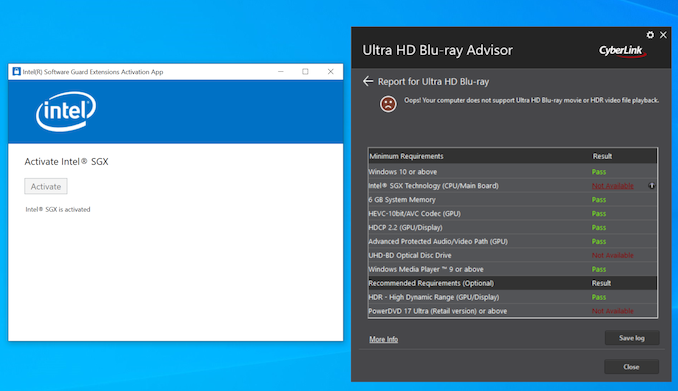Intel NUC10i7FNH Frost Canyon Review: Hexa-Core NUC Delivers a Mixed Bag
by Ganesh T S on March 2, 2020 9:00 AM ESTHTPC Credentials - Display Outputs Capabilities
The
Supporting the display of high-resolution protected video content is a requirement for even a casual HTPC user. In addition, HTPC enthusiasts also want their systems to support refresh rates that either match or be an integral multiple of the frame rate of the video being displayed. Most displays / AVRs are able to transmit the supported refresh rates to the PC using the EDID metadata. In some cases, the desired refresh rate might be missing in the list of supported modes, and custom resolutions may need to be added.
Custom Resolutions
Our evaluation of the
The gallery below presents screenshots from the other refresh rates that were tested. The system has no trouble maintaining a fairly accurate refresh rate throughout the duration of the video playback.
High Dynamic Range (HDR) Support
The ability of the system to support HDR output is brought out in the first line of the madVR OSD in the above pictures. The display / desktop was configured to be in HDR mode prior to the gathering of the above screenshots.
The CyberLink Ultra HD Blu-ray Advisor tool confirms that our setup (
[Update (3/17/2020): While I continue to have terrible luck in enabling SGX to operate correctly with the CuberLink Ultra HD Blu-ray Advisor tool, Intel sent across proof that the Frost Canyon NUC is indeed capable of playing back Ultra HD Blu-rays.
It is likely that most consumers using the pre-installed Windows 10 Home x64 / pre-installed drivers will have a painless experience unlike mine which started off the system as a barebones version.]




















85 Comments
View All Comments
YB1064 - Monday, March 2, 2020 - link
In the temperature charts (thermal performance page), the green graph shows huge temperature spikes (~ 20 C, Furmark). Is this real? The package graph is less noisy. How are you measuring this?ganeshts - Monday, March 2, 2020 - link
All parameters are recorded using HWiNFO. We have been using the program since 2013 for recording the sensor values in all our SFF PC reviews.abqnm - Monday, March 2, 2020 - link
"A new set of value-added features include the ability to configure a RAM disk in the BIOS, mount iSCSI volumes prior to boot, and set up various network interface characteristics."These are all actually possible in the NUC8 visual bios too, though the settings are a lot harder to find, buried in the boot tab.
Ratman6161 - Monday, March 2, 2020 - link
This system isn't making a lot of sense to me from a price/performance standpoint. $605 for a bare bones? $940 as configured? Yikes!.One of the things I noticed is that there were a lot of benchmarks where the Asrock mini with the i3-8100 did pretty well against the i7 "u" cpu's. Particularly for just a standard office sort of machine, which is what I have
in mind, the i3 performs just about as well and definitely well into the more than good enough range. Of course the i3-8100 will use more juice but its also way cheaper. I just had to satisfy my curiosity so I priced out a system. The Asrock mini with an i3-9100 (vs the 8100 in the review), 16 GB DDR4, 500 GB Samsung 970 Evo (previous gen without the + to save a few bucks) and a Noctua low profile cooler for a grand total of $465.00. I've got plenty of decommissioned 2.5 inch disk drives if I need to expand. Or if I want to cheap out completely, I could use an old 2.5 inch 850 EVO 256 GB I've got laying around which would bring the price down to $375.00.
If I really wanted more CPU power, the mini would actually take an i7-9700K which would be +$275 from my local Microcenter and take the $465 configuration up to $740...still $200 under the NUC. Or a more reasonable for this system i5-9400 would add just +$65 to $530 total.
So, keeping in mind that graphics don't matter for my usage and neither does the power savings of the "U" cpu's, I just can't see the reviewed system as a viable option
Holliday75 - Monday, March 2, 2020 - link
I need 10k of them to install at buildings across the country. How soon can you build these and deliver?Holliday75 - Monday, March 2, 2020 - link
EDIT: Oh and I need ongoing hardware and kernel level support for the next 5 years with an option to extend that to 7 if needed. We boot a custom Linux image via PXE and this image changes on a regular basis along with our network infrastructure that serves it.PeachNCream - Monday, March 2, 2020 - link
I get teh point you are making, but there are also other mass-produced options other than NUC systems. Yes they are sometimes physically larger, but a SFF Dell or HP box may cost somewhat less in a bulk buy than a NUC with comparable compute power. If you need 10k fixed location systems, that would be where I would turn first rather than NUCs and certainly not use DIY builds.sandtitz - Monday, March 2, 2020 - link
That'll take about 3-4 months since Intel can't provide the CPUs...Ratman6161 - Tuesday, March 3, 2020 - link
"I need 10k of them to install at buildings across the country. "So? You have a different need than me. I just need one :). If you need them mass produced all the major manufacturers build something that's in this general size range with many different options for CPU, RAM, storage etc.
But my main point still holds. There are options for PC's that are both cheaper and more powerful than the NUC.
Irata - Monday, March 2, 2020 - link
You guys are still using Bapco benchmarks? Really?